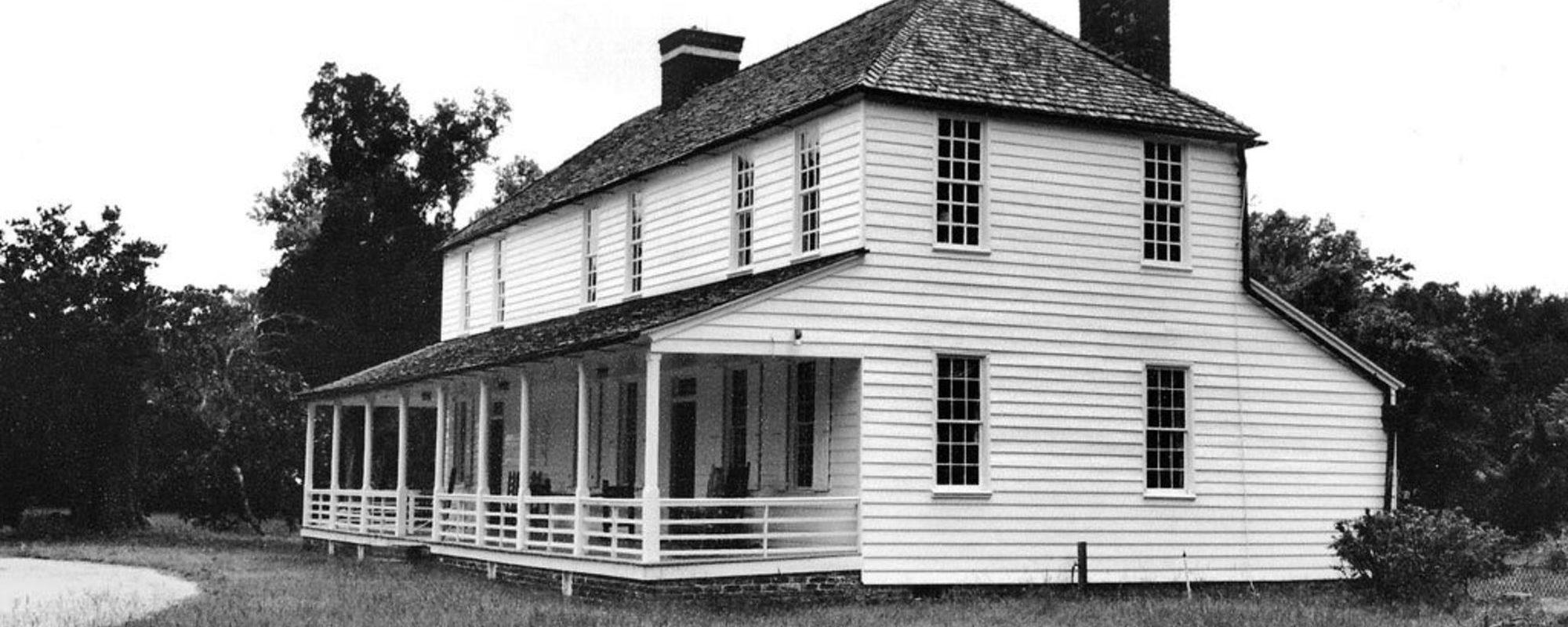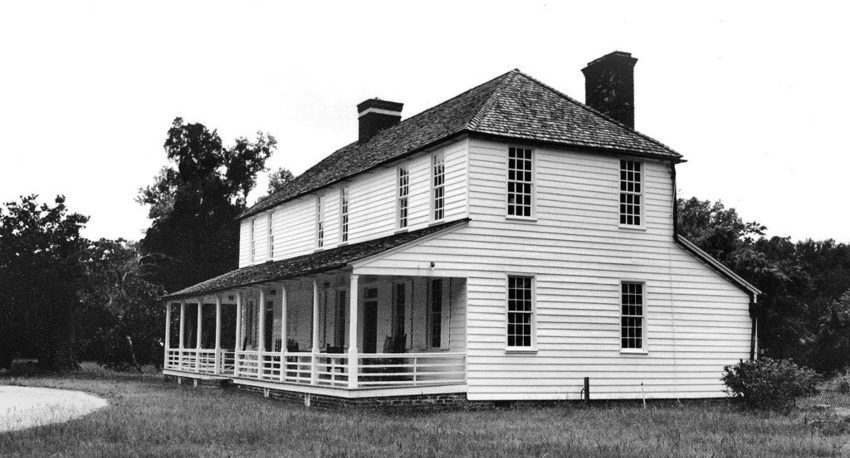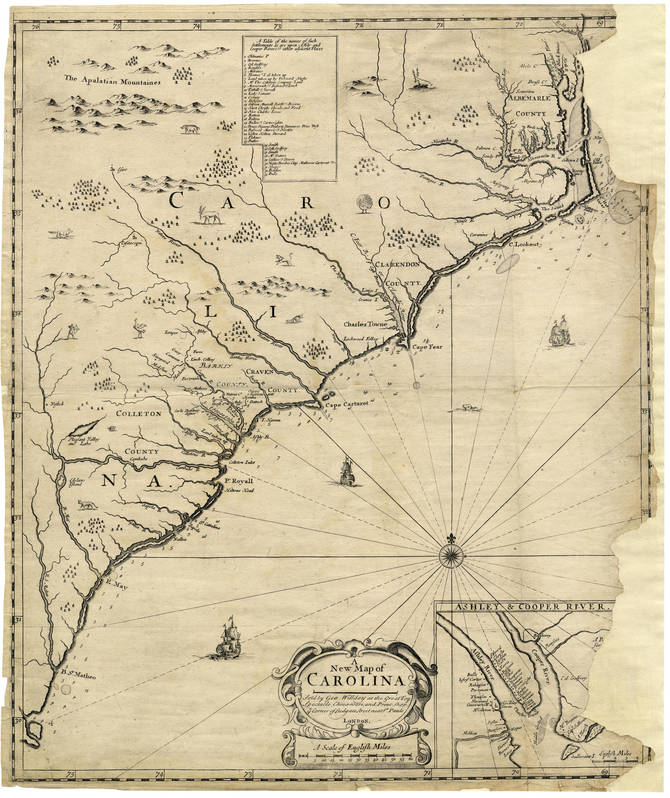A Brief History of Middleburg
17th Century
Courtesy of the state archives of North Carolina
In 1663 Great Britain’s King Charles II issued a charter to eight members of British nobility to establish the colony of Carolina. Shortly thereafter in 1670, approximately 150 British settlers arrived on the shores of what is now South Carolina near present-day Charleston. The original settlement of Charles Town saw the arrival of additional British settlers as well as a small wave of French Huguenots. The Huguenot immigrants were generally well-educated merchants, artisans, and craftsmen. The Huguenots were fleeing persecution in their French homeland for their protestant faith. They were accepted by the British but not generally seen on equal terms as they were still French. Accordingly, they were often encouraged to settle the areas inland from Charles Town which served to create a buffer from the Native Americans already established in the region.
The inland areas such as those around the Cooper River constituted a broad shallow floodplain. These backwater swamps contained cedar and cypress forests and the upland areas included loblolly, slash, pitch and longleaf pines, live oak, magnolia, cypress, hickory, gum trees and Spanish moss. Large inland swamps and tidal riverine marshes created ideal conditions for growing rice. As a result, rice plantations lined the Cooper River as early as 1695. Plantation life, slavery and rice agriculture defined the Low country and were the dominant forces that shaped the land, the culture and economy of the region through the 19thcentury.
In 1693, a 100-acre tract of land and swamp on the East Branch of the Cooper River known to the local Native American tribes as Pimlica Maptica was marked for warrant to a young French Huguenot émigré from the Bay of Biscay named Benjamin Simons. He set about clearing the land for the three primary plantation enterprises of 17th C. Carolina: cutting timber for export, making pine tar and turpentine for naval stores, and raising beef cattle for export to the sugar planters of the Caribbean.
A letter still in the possession of Simon’s descendants announces the date of completion of the main house on the property in time for the birth of his fourth child, on December 7, 1697. The original house remains today and is the oldest home still standing in the United States south of Virginia.
18th Century
Although Simon’s first land grant was not issued until 1704, his ownership was sufficiently secure by 1702 for his donation of 2 acres for the construction of Pompion (pronounced “Punkin”) Hill Chapel. This church, located on the northwest edge of the property was the first Church of England edifice to be built in the colony outside of St. Phillips in Charles Towne. The creation of this congregation, along with that of St. James in Goose Creek started a political revolution in the Proprietary Colony which resulted in the victory of the “Church Party” over the “Dissenters”. This power shift resulted in the creation of the Parish system and the eventual overthrow of the ownership of the Lords Proprietors and the conversion of the colony to Royal rule.
The original two story, gable-roofed wooden house consisted of two rooms per floor, heated by exterior brick chimneys on the gable ends, with one story porches running the length of the house. Probably by the time of Benjamin’s death in 1717, and no doubt due to the presence of his 14 children, two more rooms were added to the southwestern end, and the roof changed to a hipped roof.
The youngest son, Benjamin Simons II, inherited the plantation at age 4, and while his oldest brothers Peter and Samuel were settled on their own lands by then, the brothers managed the property while young Benjamin and his mother moved to Charles Town where he was to be apprenticed to a master builder. At that point, Middleburg ceased to be a primary year-round residence, and has remained so ever since.
Benjamin Simons II owned Middleburg until his death in 1772, and during that time, increased his family to 11 children, and increased Middleburg’s size from 350 acres to 3,342, with the bulk of the land devoted to the production of rice, grown inland in rice fields formed from dammed streams. When England was at war with France, indigo was produced as well, and when French indigo was available, planters were subsidized to produce it in order to retain the skills of the workers. Upon Benjamin Simons II death, Middleburg passed to his eldest son, Benjamin Simons, III.
Benjamin III’s tenure witnessed the devastation of the economy and the neighborhood due to the lull caused by the American Revolution between 1775 and 1783, and the loss of their primary English market. During the early years of the Revolution the conflict escaped much of the area but from 1780-1782 the war came in dramatic fashion to the Charleston area. During this time, the land around Middleburg was the center of dozens of pitched battles. General Francis Marion earned his nickname, “The Swamp Fox” through his guerrilla warfare harassment of British Col. Banastre Tarleton and his troops in the surrounding swamps. The house itself was set to be torched by Col. Banastre Tarleton. Why the British left without firing the house is not known, but their presence is still witnessed by the mark of what is alleged to be Col. Tarleton’s saber in a column by the front door.
After the war Benjamin III spent much of his effort rebuilding and redeveloping Middleburg’s rice fields from the ancient and flood-prone inland system to the newly-developed tidally flooded and drained system.
Plats dating from 1772 to 1789 show the existence of the kitchen house and that the construction of the 100 acres of riverfront fields took years, and that they were not quite finished by the time of Benjamin III’s death in December of 1789. While Benjamin Simons III had 10 children, only three young daughters survived him, and upon his death in 1789, Middleburg passed to his youngest, 7-year-old Sarah Lydia Simons.
Her marriage to a young Englishman, Jonathan Lucas, Jr. in 1799 at the family summerhouse on SeeWee Bay marked the beginning of a complete restructuring of Middleburg and changed the focus from growing rice to milling rice. Although Jonathan and his father were known for building private rice mills on individual plantations, he completed the first large public toll mill at Middleburg in 1801. He also redesigned Middleburg, moving the field hand quarters from the area now occupied by the stable ruins, moved the barns away from the house, and abandoned the 17th c gardens on the land side of the house, moving them to the riverside. He also built new servant’s quarters next to the house, a Flemish-style stable inspired by a visit to the Town of Middelburg in Zeeland, and the toll office and rice mill. The Commissary was also built sometime around 1820.
19th Century
With the overwhelming success of the mill, Lucas proceeded to buy and build large rice mills in Charleston, then around the world, enabling him to ship rough un-milled rice to foreign markets. He invented and patented a new method for milling grain with rollers in 1808 and had become an American citizen at that time. After one of his slaves was charged and hanged as one of the primary leaders of the Denmark Vesey slave revolt in 1822, he moved his wife and ten youngest children to his estate in London, and for ten years ran his worldwide empire from there, including plantations growing rice in the Lowcountry (Middleburg, Old Town, Rice Hope-Santee), cotton in Egypt, indigo in Hindustan, dozens of rice mills in Charleston, England, Germany, Belgium, and Egypt, and real estate housing developments in London.
Upon his death in 1832, his son Jonathan Lucas, III ran his enterprises, eventually purchasing Middleburg at auction from his brothers and sisters in 1840. His most noticeable improvement to Middleburg was the avenue of oaks (c. 1832). At the death of Jonathan Lucas, III, in 1848 Middleburg passed to his children, and was run first by his son Thomas Bennett Lucas, and then upon his untimely death in 1858, his brother, Simons Lucas stepped in as executor. Middleburg was leased out to Dr. Benjamin Huger, and mortgaged to the estate of a child, John Coming Ball.
The Civil War came late to Middleburg when on Feb. 14, 1865, a band of Union Army looters called Potter’s Raiders burned the neighborhood but were stopped at Middleburg by the arrival of the Union Army. All the Middleburg slaves were assembled, a roster made, they were told that they were “free as birds”, and with that, they went back to work. Over time, as more and more of the skilled laborers moved away, the quality of the crop diminished, but in 1872, John Coming Ball came into his inheritance, foreclosed on the unpaid mortgages his father’s estate had lent, and became one of the few successful post-war rice planters.
20th Century – Present
Although not a descendant of Benjamin Simons, John Coming Ball soon married one, and Middleburg continued in the possession of the Simons descendants. Middleburg continued to grow, mill, and export Carolina Gold rice until 1926, but with Ball’s death in 1927, the rice era drew to a close in Charleston.
John Coming Ball’s daughter, Marie Guerin Ball (Dingle), and her husband, the noted ornithologist and painter Edward Von Siebold Dingle lived at Middleburg growing timber, raising sheep, and leasing the rice fields to hunt clubs. During this tenure, the Great Depression brought ruin to the economy. This period also saw perpetual flooding of the East Branch of the Cooper due to the outflow of the newly constructed Santee-Cooper system. The Dingle’s dismantled the rice mill, the overseer’s house, and several other structures due to the need for maintenance and lack of funds. Upon Ms. Dingle’s death in 1963, the title passed to her four nephews, John, Coming, Charles, and James Gibbs, even though Mr. Dingle continued to live at Middleburg until his death in 1975.
The Gibbs family made the difficult decision to sell Middleburg, and in 1981, transferred title to Jane and Max Hill. The Hills were the first owners since 1693 that were not descendants of the original Simons family. The Hills sold Middleburg to H. Martin Sprock III in 1915 and Sprock subsequently sold Middleburg to Whitewater in 2021. Whitewater is a non-profit dedicated to the conservation of and engagement with the region’s endangered assets. Middleburg has entered its fourth century still recognizable to its builder, and thanks to a conservation easement placed on the property and the stewardship of the non-profit, Whitewater, it will remain so for generations to come.



